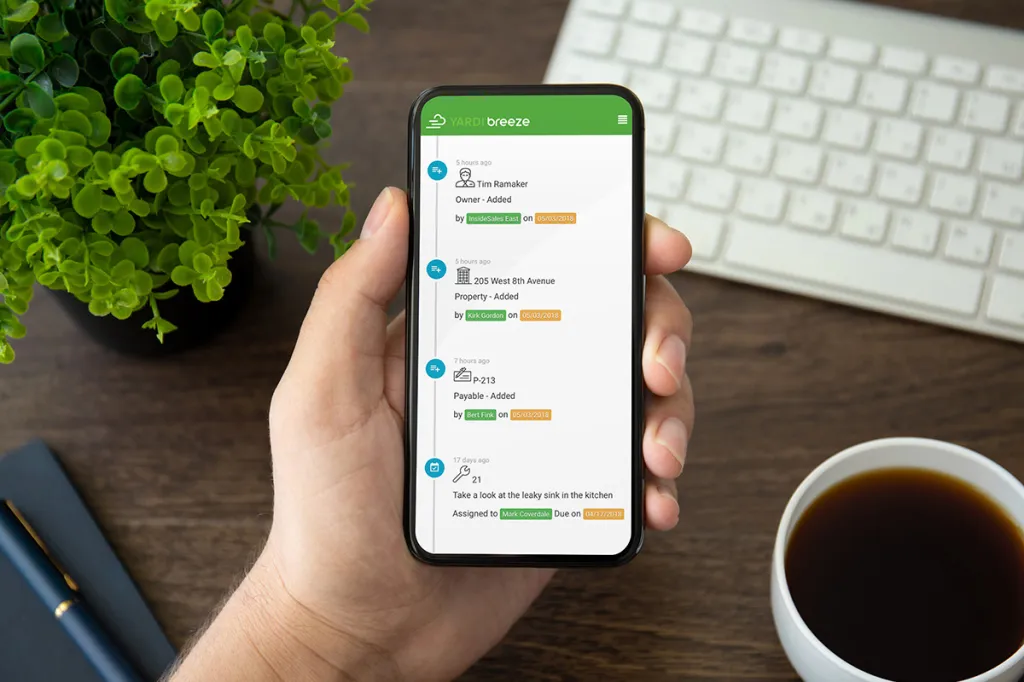You may have noticed the term biophilic design cropping up on the internet for a while now. At first, we weren’t sure what to make of it. Then we started to see stunning images of biophilic design in the real world, inspired by real science. It became clear that biophilic design is something property managers can employ to spruce up (pun intended) their own offices, enrich their tenants’ workspaces and help make the indoor, professional world a fresher, happier place to be.
This article covers what biophilic design is, why it works and where it can be implemented. Just as important as understanding biophilic design is to understand what it is not, so we’ll cover that too. Let’s start off with the basics.

Biophilic design: More than adding plants
Let’s start with the Wikipedia definition of biophilic design:
“A concept used within the building industry to increase occupant connectivity to the natural environment …”
Adding a few potted plants has been shown to significantly increase feelings of well-being in the workplace. So yes, plants are central to biophilic design, but there’s so much more to it.
Biophilic design offers a way to bridge the divide between indoor and outdoor worlds. Rather than thinking of it as putting a plant in the office, you’d want to think of ways the plant can become part of your indoor environment — as much as any wall or window. If this sounds like pseudo-science, it’s not! Biophilic design is based in real science.
Let’s talk about that.
Why biophilic design works
There’s been a lot of research done on the benefits of biophilic design in professional settings. Dozens of studies have confirmed that the elements of nature improve mental and physical health. The reason comes from the word biophilia, which means “love of life, or living systems.” It’s that feeling you get standing next to a roaring waterfall or a secluded, pristine forest. Humans come from nature, evolved in nature and thrive when we are connected to the natural world. The living world grounds us and helps us find meaning and happiness in life.
Staying connected
When our connection to nature is missing in the workplace, there is a negative effect on brain power, focus, happiness and overall health. These feelings all stem from the absence of greenery and therefore a feeling of separation from plants and the natural world.
The good news is that even a property manager whose building is suffering from a lack of greenery can turn things around. Here are some ideas:
- Invest in potted plants to cover the office, making that green color the predominant visual tone within the space
- Make sure there’s plenty of natural light (skylights, windows, glass walls, etc.)
- Cultivate “green walls” of ivy and moss
- Install plant walls, a cost-effective way to keep heat out in the summer and keep your building warmer in the winter
- Go beyond greenery and incorporate water: ponds, fountains and even small waterfalls
- Plant a garden (indoors or outdoors) with a walking path, tables and benches
- Create shaded spaces for increased enjoyment of the outdoors
We’re particularly impressed by some of the vertically oriented biophilic designs in these offices. Some plants are easy to care for, thriving in almost any kind of light with minimal care. There are vines and ivy that look amazing, and a single, inexpensive plant can cover a lot of space!
Why employers should care
Businesses that inspire their team will see benefits that affect the business and their bottom line. Research has found biophilic design makes people happier and healthier, but it also makes them more productive, energetic and creative at work. It’s easy to see the positive snowball effect this can have:
- It will be easier to recruit and retain employees to an attractive workplace
- The office will be a more enjoyable place to spend eight-hour workdays
- More work will get done in less time
- There will be less stress and discord among the team
It’s hard to see how adding greenery could possibly be bad … unless nobody took care of the plants. (We didn’t find any research on the effect dead plants have on mental health, but we’re guessing it’s not good.)
What is NOT biophilic design?
Biophilic design offers a way for businesses to bridge the divide between indoor and outdoor worlds. However, if this “bridge” is handled in a crude or inauthentic manner, there will be little, if any, benefit.
Let’s imagine a property manager who wants to attract and retain talent with the help of biophilic design elements. That’s a great start, but simply adding plant life and sunlight is not a strategy in and of itself. Greenery is not a tool that directly drives efficiency. It is something that is felt, experienced and enjoyed by everyone in the building. Those positive feelings are what help drive efficiency.
If a property manager wanted to save time and money, streamline operations and simplify training, they might consider property management software. That’s a bona fide tool toward that end. Implementing biophilic design at the office is simply a way to enhance the experience of being at work.
Here are some examples of initiatives that do not count as biophilic design:
- Minimal exposures to nature that have little effect on wellbeing
- Interactions with greenery that do not occur where people spend most of their time
- Greenery that feels disconnected to other elements in the workspace
- An isolated plant on the receptionist’s desk
- Green carpeting meant to resemble grass
- An artistic rendering of nature such as a mural or painting
- Pale imitations of the natural world
- Fake plastic trees
- Audio reproductions of calming nature sounds
Biophilic design requires intentionality
When adding biophilic design elements to the workplace, think like an architect. That means you should consider the layout of the building as well as the spacing and movement of the people who work there. Then find ways to integrate nature at every turn. Biophilic design is about cultivating a stronger, healthier relationship between humans and indoor spaces. These positive experiences can inspire your team and increase feelings of goodwill about their work and livelihood. Biophilic design helps build your brand and even market your properties. The key is to be intentional when integrating natural elements within the building.



